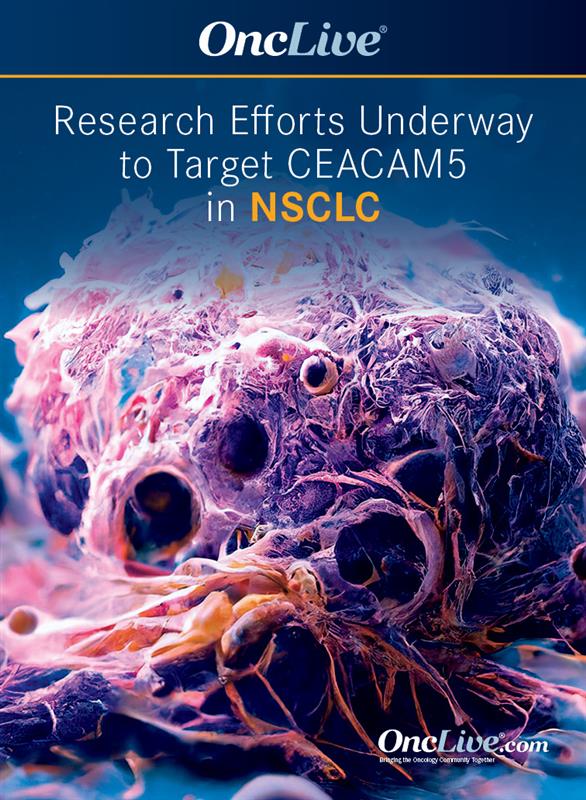CEACAM5-Directed Tusamitamab Ravtansine Progresses to Phase 3 Trial in NSCLC
Clinicians tasked with treating patients with non–small cell lung cancer may soon be gaining an additional therapeutic target, this one directed at CEACAM5.
Martin F. Dietrich, MD, PhD

Clinicians tasked with treating patients with non–small cell lung cancer (NSCLC) may soon be gaining an additional therapeutic target, this one directed at CEACAM5. Considering the positive preclinical and early-phase findings observed with tusamitamab ravtansine (SAR408701), investigators have initiated the phase 3 CARMEN-LC03 trial (NCT04154956) to further confirm the utility of the marker for this patient population.
CEACAM5 is not highly expressed in several normal tissues, including colon, esophagus, and head and neck. However, the protein is often highly expressed in a few tumor types, such as gastrointestinal, breast, and lung.1,2
“CEACAM5 is present in about 25% of lung cancers in high expression, and another 20% or so in moderate expression,” Martin F. Dietrich, MD, PhD, a medical oncologist at Florida Cancer Specialists & Research Institute and an assistant professor of internal medicine at the University of Central Florida in Orlando, said in an interview with OncologyLive®. “We see a differentiator there between surface expression on tumor cells and surface expression on normal tissue. We see some expression in squamous cells as well, but not nearly as commonly as in the nonsquamous histologies.”
One CEACAM5-directed agent making waves in the NSCLC space is the novel antibody-drug conjugate (ADC) tusamitamab ravtansine, which is engineered using a humanized monoclonal antibody and a cytotoxic maytansinoid, DM4. The monoclonal antibody binds to CEACAM5, and the maytansinoid targets CEACAM5-expressing tumor cells. In preclinical studies, the agent was proven to selectively bind to CEACAM5 in human tissue and displayed cytotoxic activity, leading investigators to mark it as a promising treatment option for patients with CEACAM5-positive tumors.3
Tusamitamab Ravtansine Performs Well in Early-Phase Trial
Following preclinical study, investigators initiated an ongoing phase 1/2 trial (NCT02187848) to evaluate tusamitamab ravtansine in patients with solid tumors. Eligible adult patients were required to have and ECOG performance status of 1 or 0 and locally advanced/metastatic solid tumors that expressed or were likely to express CEACAM5.
In the dose-escalation phase 1 portion of the trial, 31 patients received tusamitamab ravtansine at doses ranging from 5 to 150 mg/m2, given every 2 weeks intravenously (IV). A dose-limiting toxicity of reversible grade 3 microcystic keratopathy was reported in 3 of the 8 patients who received tusamitamab ravtansine 120 mg/m2 and in 2 of the 3 patients who received 150 mg/m2. Investigators determined the maximum-tolerated dose (MTD) of tusamitamab ravtansine to be 100 mg/m2 IV every 2 weeks.1
As of January 2020, 92 patients were treated at the MTD in the nonsquamous NSCLC cohort of the trial. Twenty-eight of these patients were moderate expressors of CEACAM5 (immunohistochemistry [IHC] ≥ 2+ on 1%-50% of tumor cells) and 64 were high expressors (IHC ≥ 2+ on ≥ 50% of tumor cells). The median age of the treated patients was 62.5 years (range, 31-91) and the median number of prior lines of therapy for advanced disease was 3 (range, 1-10). Most patients were men (51.1%) and most had an ECOG performance status of 1 (71.7%).4
Findings from the trial showed that the overall response rate (ORR) among moderate expressors was 7.1% (95% CI, 1.98%-22.65%), with all responses being confirmed partial responses (PRs). Additionally, 53.6% of patients experienced stable disease (SD), the disease control rate (DCR) was 60.7%, and 35.7% had progressive disease (PD). One patient in this subgroup was not evaluable (NE) at the time of the analysis.
Comparatively, patients in the high-expressor cohort achieved an ORR of 20.3% (95% CI, 12.27%-31.71%), with all responses being PRs. Patients in this subgroup experienced SD at a rate of 43.8%, a DCR of 64.1%, and 32.8% had PD. Two patients were NE.
In the overall nonsquamous NSCLC cohort, the most common treatment-emergent adverse effects (TEAEs) were asthenia (38.0%), keratopathy/keratitis (38.0%), peripheral neuropathy (26.1%), dyspnea (23.9%), and diarrhea (22.8%). Common hematologic toxicities included leukopenia (14.4%), thrombocytopenia (13.3%), and neutropenia (4.4%). Dose modifications due to TEAEs occurred in 33.7% of patients, 10.9% of which were associated with keratopathy/keratitis. Grade 3 or greater TEAEs were reported in 47.8% of patients.
Corneal TEAEs leading to dose modification occurred in 27.2% of patients. Ten of these patients experienced at least 1 dose reduction, and 1 patient was forced to discontinue treatment. The median time to recovery from this type of TEAE was 18.5 days (range, 2-82).
“The most common notable adverse effect is keratopathy, followed by peripheral neuropathy, as you would expect from a tubulin inhibitor,” Dietrich said. “[There are also] some GI [gastrointestinal] toxicities, not untypical for chemotherapy. The keratitis/keratopathy is an on-target effect and will require monitoring and management.”
Additional data from the trial, which encompassed patients treated over a long term, were presented at the 2022 American Society of Clinical Oncology Annual Meeting. In this analysis, the study authors focused on patients who had undergone treatment with tusamitamab ravtansine for at least 12 months as of December 2021.5
Findings showed that 24 patients were treated for at least 6 months, 15 patients for at least 9 months, 11 patients for at least 12 months, 6 patients for at least 24 months, and 2 patients for at least 42 months. Five patients remained on treatment at the data cutoff, 1 of whom has remained on treatment for more than 52 months. Among patients who were treated for at least a year, the median duration of treatment was 26.6 months (range, 12.1-45.3).
Patients in this cohort had a median age of 61 years (range, 41-91), and 81% had high CEACAM5 expression. The median number of prior regimens for advanced disease was 2 (range, 1-6), with 54.5% of patients having received prior anti–PD-1/PD-L1 therapy and 45.5% having received antitubulin therapy.
Of the patients who experienced a PR in the January 2020 analysis (n = 15), PR was still reported in 67% of patients who were treated for at least 6 months, 53% of patients who were treated for at least 9 months, and 47% of patients who were treated for at least 1 year. Additionally, patients who were treated for at least 1 year had better ECOG performance status and underwent fewer prior treatment regimens compared with the overall group. PR was also found to occur regardless of CEACAM5 expression level in patients who received tusamitamab ravtansine for at least 1 year.
In terms of safety, investigators noted that only 1 patient who was treated for at least 12 months was forced to discontinue treatment due to a TEAE, which was breast cancer. The most common TEAEs were corneal events; any-grade corneal TEAEs occurred in 73% of patients, with 36% of these being grade 3 or greater. Treatment was delayed or the dose was reduced in 7 patients, and no corneal TEAEs were deemed serious or led to treatment discontinuation.
Investigators concluded that heavily pretreated patients exhibited a durable and frequently sustained response to treatment with tusamitamab ravtansine, adding that further clinical development of the agent is warranted.
“In the second-line [setting], we’ve had very transient progress with immunotherapies that then moved up into the first-line space,” Dietrich said. “So, that makes it a wide-open field. There’s been really no progress in the second-line setting beyond targeted therapies, such as KRAS or EGFR exon 20 inhibitors and docetaxel with or without ramucirumab has remained the comparative benchmark. [This agent] is going to change the way we’re going to apply our therapies in the second line dramatically and open a new set of opportunities for patients. In fact, the second-line dynamic is going to also [affect] how are we going to approach the future in the first-line setting, because we’ve certainly run up against a wall in intensification of immunotherapies.”
Pivotal CARMEN-LC03 Trial Aims to Validate Tusamitamab Ravtansine
CARMEN-LC03 will enroll approximately 450 adult patients with NSCLC and an ECOG performance status of 1 or 0 who have experienced disease progression following treatment with platinum-based chemotherapy and an immune checkpoint inhibitor (ICI). Additionally, patients must have exhibited CEACAM5 expression in at least 50% of tumor cells at an intensity of at least 2+ to be included in the study2,6.
“This will be the first usage of this regimen in the second-line setting,” Dietrich noted.
Patients enrolled on the open-label trial will be randomly assigned to receive tusamitamab ravtansine monotherapy or the standard-of-care treatment docetaxel. Treatments will be given at a dose of 100 mg/m² IV every 2 weeks or 75 mg/m² IV every 3 weeks, respectively. Patients will be stratified based on ECOG performance status, previous ICI treatment, and geographic region.
The coprimary end points of the study are PFS and OS. Secondary end points include ORR, health-related quality of life, safety, and DOR. The trial is recruiting patients and has an anticipated completion date of August 2024.
“There are a number of additional trials that are looking at combining this agent with an anti-VEGF agent to match the frequent reality of ramucirumab upon disease progression in first line,” Dietrich said. “There are also first-line trials [such as] CARMEN-LC05 [NCT04524689], which is a combination with pembrolizumab [Keytruda] plus carboplatin. Those are going to be the developmental pipeline. We’re expecting this agent to be approved sometime in early 2024 and be available for patients shortly thereafter as a new opportunity for treatment.”
References
- Gazzah A, Bedard PL, Hierro C, et al. Safety, pharmacokinetics, and antitumor activity of the anti-CEACAM5-DM4 antibody-drug conjugate tusamitamab ravtansine (SAR408701) in patients with advanced solid tumors: first-in-human dose-escalation study. Ann Oncol. 2022;33(4):416-425. doi:10.1016/j.annonc.2021.12.012
- Johnson ML, Chadjaa M, Yoruk S, Besse B. Phase III trial comparing antibody-drug conjugate (ADC) SAR408701 with docetaxel in patients with metastatic non-squamous non-small cell lung cancer (NSQ NSCLC) failing chemotherapy and immunotherapy. J Clin Oncol. 2020;38(suppl 15):TPS9625. doi:10.1200/JCO.2020.38.15_suppl.TPS9625
- Decary S, Berne PF, Nicolazzi C, et al. Preclinical activity of SAR408701: a novel anti-CEACAM5-maytansinoid antibody-drug conjugate for the treatment of CEACAM5-positive epithelial tumors. Clin Cancer Res. 2020;26(24):6589-6599. doi:10.1158/1078-0432.CCR-19-4051
- Gazzah A, Ricordel C, Cousin S, et al. Efficacy and safety of the antibody-drug conjugate (ADC) SAR408701 in patients (pts) with non-squamous non-small cell lung cancer (NSQ NSCLC) expressing carcinoembryonic antigen-related cell adhesion molecule 5 (CEACAM5). J Clin Oncol. 2020;38(suppl 15):9505. doi:10.1200/ JCO.2020.38.15_suppl.9505
- Ricordel C, Barlesi F, Cousin S, et al. Safety and efficacy of tusamitamab ravtansine (SAR408701) in long-term treated patients with nonsquamous non-small cell lung cancer (NSQ NSCLC) expressing carcinoembryonic antigen-related cell adhesion molecule 5 (CEACAM5). J Clin Oncol. 2022;40(suppl 16):9039. doi:10.1200/ JCO.2022.40.16_suppl.9039
- SAR408701 versus docetaxel in previously treated, carcinoembryonic antigen-related cell adhesion molecule 5 (CEACAM5) positive metastatic non-squamous non-small-cell lung cancer patients (CARMEN-LC03). ClinicalTrials.gov. Updated January 13, 2023. Accessed February 8, 2023. https://clinicaltrials.gov/ct2/show/NCT041549




